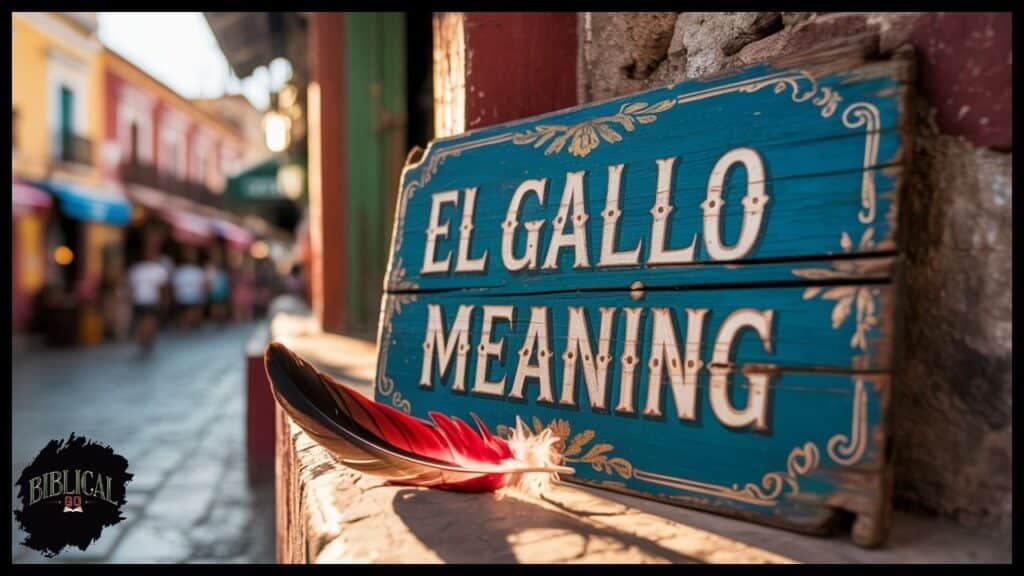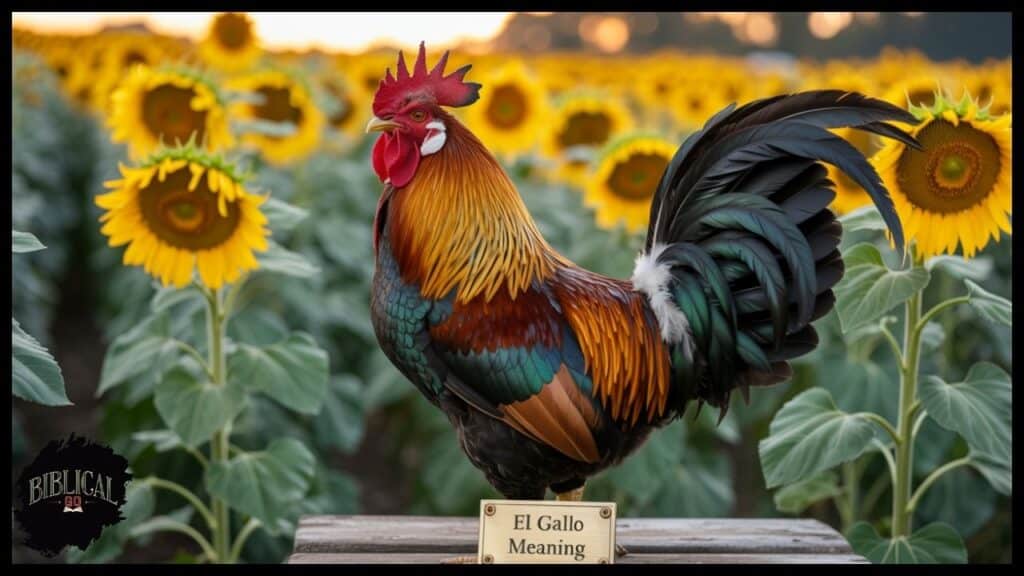El Gallo Meaning: When you hear “el gallo” in Spanish conversation, you’re encountering far more than just another word for rooster. This powerful term carries centuries of cultural weight, from ancient folklore to modern street slang, making it one of the most symbolically rich expressions in Latin American culture.
What does el gallo mean exactly? While the literal translation is simply “the rooster,” its deeper significance spans religion, politics, cuisine, and daily life across Spanish-speaking communities worldwide.
Beyond the Barnyard: Understanding El Gallo’s True Power
El gallo meaning extends far beyond its basic definition. In Spanish-speaking cultures, this term represents masculine strength, leadership, and the dawn of new possibilities. From Mexico’s vibrant folklore to Spain’s historic traditions, the rooster has crowed its way into the heart of cultural identity.
The word itself carries different pronunciations across regions – [el GAH-yoh] in Mexico versus [el GAH-llo] in Argentina – yet its symbolic power remains universally understood. El gallo in english translates directly to “the rooster,” but this simple translation misses the cultural depth that makes this term so significant.
The Linguistic Foundation of El Gallo
Etymology and Evolution
The Spanish word “gallo” traces back to the Latin “gallus,” sharing roots with French “coq” and Italian “gallo.” This linguistic family tree reveals how rooster symbolism spread throughout Romance language cultures, each adopting unique interpretations while maintaining core symbolic meanings.
Regional pronunciation variations create interesting distinctions:
- Mexico: Clear emphasis on the double-L sound
- Argentina: Softer pronunciation with yeísmo
- Spain: Traditional Castilian pronunciation
- Caribbean: Rapid, clipped delivery
Modern Usage Patterns
Contemporary Spanish culture has embraced “el gallo” in countless expressions. You’ll hear it in everything from casual conversation to formal literature, with each context adding layers to its meaning.
Cultural Symbolism Across Latin America
Core Symbolic Meanings
El gallo embodies several universal concepts across Latin American cultures:
Masculine Strength and Leadership The rooster’s natural dominance in the barnyard translates directly to human social dynamics. In Mexican folklore, calling someone “el gallo del gallinero” (the rooster of the henhouse) acknowledges their leadership role within a group.
Dawn and New Beginnings Every culture recognizes the rooster’s role as herald of the dawn. This connection makes el gallo a powerful metaphor for fresh starts, hope, and transformation. Religious communities particularly embrace this symbolism, connecting it to spiritual awakening.
Pride and Territorial Behavior The rooster’s proud strut and territorial nature resonate deeply with concepts of honor and dignity. This aspect appears frequently in rooster idioms and everyday expressions.
Regional Cultural Variations
| Country | Primary Symbolism | Common Usage |
|---|---|---|
| Mexico | Machismo, Pride | “Ser muy gallo” (being tough) |
| Colombia | Resistance, Defiance | “¡Qué gallo!” (what trouble!) |
| Spain | Anger, Irritation | “Estar gallo” (being mad) |
| Puerto Rico | Celebration, Joy | Festival contexts |
Modern Slang and Street Usage
Contemporary El Gallo Slang
El gallo slang varies dramatically across Spanish-speaking communities. Understanding these nuances helps decode regional conversations and cultural references.
Mexican Slang Applications:
- “Hacer un gallo” – Making a mess or mistake
- “Estar de gallo” – Being in a bad mood
- “El gallo más gallo” – The toughest guy around
Colombian Expressions:
- “¡Qué gallo tan bravo!” – What a difficult situation!
- “Ese man es un gallo” – That guy’s a fighter
Spanish Peninsula Usage:
- “Ponerse gallo” – Getting angry or confrontational
- “Cantar como un gallo” – Speaking loudly or boastfully
Generational Differences
Younger Spanish speakers often use el gallo in digital contexts, creating new meanings through social media and text messaging. These evolving uses demonstrate how traditional symbols adapt to modern communication.
Pop Culture and Entertainment Revolution
Music and Musical Heritage
Vicente Fernández’s legendary song “El Gallo de Oro” exemplifies how rooster symbolism permeates Latin music. The song portrays the rooster as a defiant, brave figure who refuses to surrender despite overwhelming odds.
Key lyrics showcase the cultural depth:
“Soy el gallo de oro que no se raja” (I’m the golden rooster who doesn’t give up)
Rooster in Latin music appears across multiple genres:
- Mariachi: Traditional celebrations of masculine pride
- Ranchera: Stories of heartbreak and resilience
- Modern Reggaeton: Urban interpretations of strength
- Folk Music: Regional tales and legends
Film and Television Impact
Mexican cinema has featured countless films using el gallo themes. These movies typically explore:
- Masculine honor and dignity
- Rural vs. urban life contrasts
- Traditional values vs. modern challenges
- Family loyalty and community bonds
Telenovela archetypes frequently include the “gallo” character – the proud, stubborn male lead who must learn humility through love and loss.
Literary Significance
Rooster in literature spans from classical Spanish poetry to contemporary Latin American novels. Authors use el gallo to represent:
- Masculine identity crises
- Cultural resistance movements
- Spiritual transformation
- Social class tensions

Lucha Libre and Sports Culture
Wrestling Personas and Masks
El Gallo Lucha Libre represents one of Mexico’s most beloved wrestling traditions. Famous luchadores who’ve adopted rooster personas include:
- El Gallo: The original rooster wrestler
- El Gallo Negro: The black rooster with mystical powers
- Gallo de Oro: The golden rooster champion
Wrestling mask designs incorporate traditional rooster iconography:
- Vibrant feather patterns
- Prominent combs and beaks
- Bold color schemes representing different regions
Sports Team Mascots
Professional teams across Latin America embrace rooster as national symbol:
Notable Teams:
- Club Deportivo El Gallo (Mexico)
- Los Gallos Blancos (Querétaro FC)
- Galo Atlético Mineiro (Brazil)
These teams leverage the rooster’s fighting spirit and territorial nature to inspire fans and intimidate opponents.
Culinary Traditions and Gastronomy
Traditional Rooster Dishes
Gallo en mole stands as Mexico’s most celebrated rooster dish. This complex preparation involves:
Traditional Preparation Method:
- Selecting the bird: Free-range roosters preferred
- Marinating process: 24-hour spice infusion
- Mole preparation: 20+ ingredient sauce
- Slow cooking: 4-6 hour braising process
- Final presentation: Garnished with sesame seeds
Regional Specialties Include:
| Dish | Country | Key Ingredients |
|---|---|---|
| Gallo Pinto | Costa Rica/Nicaragua | Rice, black beans, rooster |
| Sopa de Gallo | Caribbean | Rooster broth, vegetables |
| Arroz con Gallo | Spain | Saffron rice, rooster pieces |
| Gallo al Mattone | Italy | Brick-pressed rooster |
Restaurant Culture and Branding
Mexican rooster dishes have inspired restaurant chains and street food vendors throughout Latin America. Popular establishments use el gallo branding to suggest:
- Authentic traditional cooking
- Bold, robust flavors
- Masculine dining experiences
- Regional cultural pride
Religious and Spiritual Significance
Catholic Symbolism and Iconography
Rooster in Christianity carries profound meaning, particularly in Catholic traditions. The most significant connection comes from Saint Peter’s denial of Jesus, when the rooster crowed three times as predicted.
Biblical Reference:
“Before the rooster crows, you will disown me three times” – Matthew 26:34
This event established the Catholic rooster symbol as representing:
- Vigilance in faith
- Repentance for sins
- Redemption through acknowledgment
- Spiritual awakening to truth
Church architecture frequently incorporates rooster imagery:
- Weather vanes on church towers
- Stained glass window designs
- Altar decorations and carvings
- Processional banners and flags
Indigenous and Folk Beliefs
Pre-Columbian cultures embraced rooster symbolism even before Spanish colonization introduced domestic roosters. Indigenous communities associated similar bird symbols with:
- Solar deities and dawn rituals
- Warrior spirits and battle courage
- Fertility ceremonies and agricultural cycles
- Shamanic practices and spiritual communication
Modern spiritual traditions blend these ancient beliefs with Catholic symbolism, creating unique syncretic practices found throughout Latin America.
Festivals and Cultural Celebrations
Major Rooster Festivals
Día del Gallo celebrations occur throughout Spanish-speaking countries, each with regional variations:
Mexico’s Rooster Festivals:
- Guadalajara’s Festival del Gallo: Three-day celebration featuring music, dance, and cuisine
- Oaxaca’s Guelaguetza: Traditional rooster dances and competitions
- Veracruz’s Carnaval: Elaborate rooster-themed floats and costumes
Colombia’s Celebrations:
- Festival de los Gallos: Medellín’s annual rooster tribute
- Carnaval de Barranquilla: Rooster costume competitions
Religious Observances
Rooster festivals often coincide with Catholic holy days:
- Easter celebrations: Resurrection symbolism
- Saint Peter’s feast day: Remembrance of the rooster’s crow
- New Year observances: Fresh beginning symbolism
The Controversial Legacy of Cockfighting
Historical Context
Cockfighting represents one of the most complex aspects of el gallo culture. This practice, while controversial, remains deeply embedded in Latin American heritage.
Historical significance includes:
- Spanish colonial introduction
- Indigenous adaptation and integration
- Social bonding and community gathering
- Economic impact on rural communities
Modern Legal Status
Cockfighting legality varies dramatically across regions:
| Country/Region | Legal Status | Penalties |
|---|---|---|
| Mexico | Regulated in some states | Fines up to $5,000 |
| Puerto Rico | Legal with restrictions | Licensed venues only |
| Colombia | Illegal since 2017 | Criminal charges possible |
| Spain | Regional variations | Catalonia banned, Andalusia allows |
Cultural Preservation Debates
Communities struggle to balance animal welfare concerns with cultural preservation. Many regions now promote:
- Symbolic competitions without actual fighting
- Cultural education about historical significance
- Alternative celebrations maintaining traditions
- Tourism adaptations showcasing heritage respectfully
Business and Branding Applications
Commercial Usage Patterns
El gallo branding appears across numerous industries:
Restaurant Chains:
- Emphasis on authentic Mexican cuisine
- Family-friendly traditional atmosphere
- Regional specialties and recipes
- Cultural celebration themes
Sports and Entertainment:
- Team mascots and logos
- Wrestling promotional materials
- Music label branding
- Festival merchandise
Consumer Products:
- Hot sauce and spice companies
- Textile and clothing brands
- Decorative art and crafts
- Tourism promotional materials
Marketing Strategies
Successful el gallo marketing typically emphasizes:
- Authenticity and cultural connection
- Strength and reliability
- Tradition and family values
- Pride and regional identity
Global Perspectives and International Recognition
Cross-Cultural Adaptations
El gallo symbolism extends beyond Spanish-speaking communities:
France’s Gallic Rooster (Le Coq Gaulois):
- National symbol of French republic
- Olympic games mascot heritage
- Political resistance symbolism
- Cultural export and tourism
Portugal’s Barcelos Rooster:
- Justice and good luck symbolism
- Tourist souvenir popularity
- Ceramic art traditions
- Cultural festival centerpiece
Diaspora Community Usage
Latino communities worldwide maintain el gallo traditions:
- United States: Festival celebrations in major cities
- Canada: Cultural center programming
- Europe: Immigrant community gatherings
- Australia: Latin American cultural associations
Future Evolution and Modern Adaptations
Digital Age Transformations
Social media and digital communication create new el gallo expressions:
- Emoji and emoticon usage
- Hashtag trends and viral content
- Online community discussions
- Digital art and meme creation
Generational Shifts
Younger speakers adapt traditional el gallo meanings:
- Urban reinterpretations of rural symbols
- Feminist perspectives on masculine symbolism
- Environmental consciousness about animal symbols
- Global connectivity influencing local usage
Cultural Preservation Efforts
Educational initiatives work to maintain el gallo cultural significance:
- University programs studying Latin American symbolism
- Museum exhibitions showcasing rooster artifacts
- Documentary films exploring cultural heritage
- Academic research documenting regional variations
Practical Applications for Modern Understanding
For Language Learners
Understanding el gallo meaning requires cultural context beyond simple translation:
Key Learning Points:
- Regional variations in usage and pronunciation
- Contextual appropriateness in different situations
- Cultural sensitivity when using metaphorical expressions
- Generational differences in interpretation
For Cultural Understanding
Business professionals and travelers benefit from recognizing el gallo symbolism:
- Professional contexts: Understanding colleague references
- Social situations: Participating appropriately in conversations
- Tourism experiences: Appreciating cultural performances
- Commercial interactions: Recognizing branding and marketing

Conclusion: The Enduring Legacy of El Gallo
El gallo continues evolving while maintaining its core symbolic power. From ancient folklore to modern digital culture, the rooster’s crow still announces new beginnings and celebrates the strength found in cultural identity.
This remarkable term demonstrates how language carries culture across generations. Whether you encounter el gallo in a traditional mariachi song, a wrestling match, or casual conversation, you’re experiencing centuries of accumulated meaning that connects communities across continents.
What does el gallo mean ultimately depends on context, region, and generation – but its fundamental message of strength, pride, and renewal remains constant. As Spanish-speaking cultures continue globalizing, el gallo serves as both anchor to tradition and bridge to future possibilities.
The rooster’s crow that once announced dawn in rural villages now echoes through urban streets, digital spaces, and international communities, proving that some symbols transcend time and geography to become truly universal expressions of human experience.
Understanding el gallo meaning opens doors to deeper cultural appreciation and more meaningful connections with Spanish-speaking communities worldwide. Whether you’re learning the language, exploring the culture, or simply curious about symbolic meanings, the rooster’s rich heritage offers insights into the complex beauty of Latin American traditions.
FAQs About El Gallo Meaning
What’s the real El Gallo meaning beyond just “rooster”?
El Gallo meaning goes way deeper than its literal translation – it represents masculine strength, leadership, and new beginnings across Latin American cultures, making it one of Spanish’s most symbolically powerful terms.
How does El Gallo meaning change in different countries?
El Gallo meaning varies dramatically by region – in Mexico it suggests toughness and pride, Colombia uses it for difficult situations, while Spain connects it to anger, showing how one symbol adapts to local cultures.
Why is understanding El Gallo meaning important for Spanish learners?
Grasping El Gallo meaning unlocks countless cultural references, slang expressions, and metaphors you’ll encounter in music, movies, and daily conversations throughout the Spanish-speaking world.
What role does El Gallo meaning play in modern slang?
El Gallo meaning drives popular expressions like “hacer un gallo” (making a mess) in Mexico and “¡Qué gallo!” (what trouble!) in Colombia, proving this ancient symbol stays relevant in contemporary speech.
How has El Gallo meaning influenced Latino pop culture?
El Gallo meaning shapes everything from Vicente Fernández’s legendary songs to Lucha Libre wrestling personas, demonstrating how traditional symbolism continues inspiring modern entertainment across Latin America.
Read more knowledgeable blogs on Biblical Go

Piper McMillan is a devoted writer and Bible enthusiast, offering insightful guides on Bible verses. Her blog provides practical interpretations and reflections, helping readers deepen their faith and understanding of Scripture through accessible and inspiring content.



